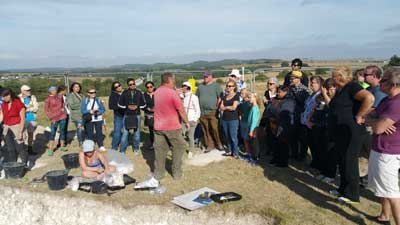

| WE HAVE JUST THE TOUR YOU ARE LOOKING FOR |
Summary of archaeological dig at Durrington Walls, August 2016.Geophysical surveys carried out in the summer of 2015 by the Stonehenge Hidden Landscapes Project (SHLP) led by Professor Vince Gaffney of Bradford News of this major new ‘discovery’ went global and was hailed as a Neolithic standing stone monument which would dwarf Stonehenge in its scale. It also had an impact on the interpretation of the archaeological digs that had taken place at Durrington Walls from 2003- 07 by the Stonehenge Riverside Project (SRP) led by Professor Mike Parker Pearson whose work was due to be published imminently. A collaborative joint project was devised involving the SHLP, the SRP, and the National Trust who own the land. Led by Professors Gaffney & Parker Pearson the joint project aimed to ‘ground truth’ ie dig into the two clearest samples of these anomalies to establish exactly what they were. It involved digging a trench 8m x 6m between the 28th July to 13th August 2016 and shown as the red rectangle on the photo (above). Academic and funding support came from several universities making up a stellar cast of specialists in the British and European Neolithic period.
Within a few days of careful hand digging one of the anomalies starts to show as shown on the right. The evidence is that the post was removed at a later date (rather than being left to rot in situ) because at the base of the pit a scapula had been deposited which would have been crushed had a large post been placed on it. Some concentric rings were also found around the base of the post hole which may indicate that they were rotated in an effort to lift the posts vertically. The hole then appears to have been filled prior to the henge bank being constructed. It is this fill of the hole and ramp that had a different density to the surrounding chalk that showed up as an anomaly in the geophysical survey and was incorrectly interpreted as recumbent stones. Other finds include a deer antler found in the packing material; an oblique arrowhead; and a lump of iron pyrites all having been deliberately deposited within the feature. Were these all votive offerings? The antler and scapula do offer the opportunity for radiocarbon dating which may give us some indication of the likely time of the dismantling of the timbers at least. So what happens next?There is plenty to consider, analyse and hypothesise on:
An intriguing mystery which will take quite some unravelling. Some early results will be available in early 2017 with a much more detailed report published in late 2017. Unfortunately no big fanfare as was made in 2015.We’ll keep you posted! We were fortunate in visiting the site during our Stonehenge tours on the 4th & 11th August and invited onto the site by Professor Parker Pearson addressing our guests with a summary of the dig. Is geophysics of any use in archaeology?The answer is very definitely yes, but… and it’s a big but. It is very useful tool in helping to indicate whether there is some kind of disturbance under the ground. It is not, however, until one digs into the ground that one can identify what is actually there. In this case the geophysics team will be able to compare the readings received initially and the reality of what was there in order to refine their interpretation on any future surveys. If you are interested in coming on any of our tours please see our Stonehenge Special Access Tours page. We are fortunate to have worked on the main archaeological digs which have taken place around Stonehenge in the last few years so you can guarantee that you will have up to date information on our tours - no other Stonehenge tour can do that!. Back to Home page |
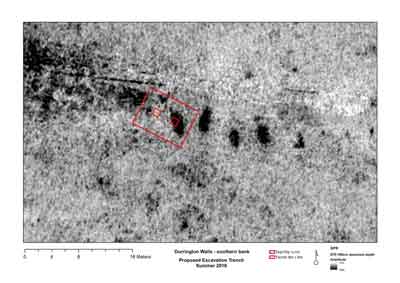 University identified an arc of anomalies at
University identified an arc of anomalies at 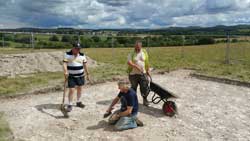 Only a very light machining of the thin top soils is needed to get down to the top of the former bank of the henge to enable an initial clean of the surface debris. Pictured are L to R: Prof Vince Gaffney; Julian Richards; Prof Mike Parker Pearson.
Only a very light machining of the thin top soils is needed to get down to the top of the former bank of the henge to enable an initial clean of the surface debris. Pictured are L to R: Prof Vince Gaffney; Julian Richards; Prof Mike Parker Pearson.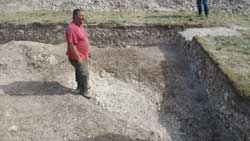
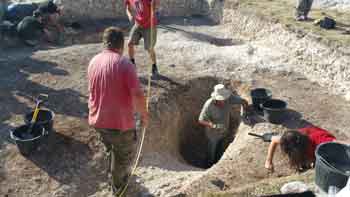 Southern Circle in 2006, and described on our tours. This ramp was probably used to offer up a large post to ease its erection. The post that it contained was probably some 60 cm in diameter and it is estimated it could have been approximately 5m high. From these dimensions the post would have weighed some 1 ½ - 3 tonnes. If there were timbers in each of the 300 anomolies that were found by the SHLP during its geophysical survey this would involve a large number of mature trees used in an area thought to have very little woodland at the time.
Southern Circle in 2006, and described on our tours. This ramp was probably used to offer up a large post to ease its erection. The post that it contained was probably some 60 cm in diameter and it is estimated it could have been approximately 5m high. From these dimensions the post would have weighed some 1 ½ - 3 tonnes. If there were timbers in each of the 300 anomolies that were found by the SHLP during its geophysical survey this would involve a large number of mature trees used in an area thought to have very little woodland at the time.